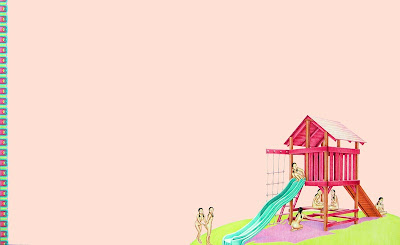
Call me old-school, but I marvel at the many young women I went to art school with who vehemently resisted identifying with the term "feminist". So I was intrigued by a small yet might show on right now in Regina that features work from some young feminist heavyweights that we don't often see in Canada--people like Chitra Ganesh (who made Dazzle, above) Laylah Ali, Wangechi Mutu, Kara Walker and the like. I spoke recently with Dunlop curator Amanda Cachia who managed to pull the whole thing off--despite resistance from some of the artists in the show both geographically and politically. Click here to read the condensed interview published in the National Post, or continue after the jump for the interview with some more images from the show.
The original outside-the-box thinker
Online Wednesday, July 09, 2008 In print Thursday, July 10, 2008
On Monday, the Church of England decided to break the "stained-glass ceiling" and allow women to become bishops. Resulting controversy lit up manses and message boards worldwide, highlighting persistent debates around women's rights. Pandora's Box, a Regina art exhibition, is now broaching similar issues in the art world. Here, curator Amanda Cachia tells Leah Sandals how the fairer sex grapples with unfair biases.
Q Why did you organize this show?
A When I was living in New York in 2006 there was lots of discussion about the dearth of feminist content in exhibitions. There was huge outcry from The New York Times and others about the lack of equal representation - even MoMA didn't have it. Based on that discussion, there started to be exhibitions on feminist art across the States. I moved to Saskatchewan in 2007 and saw there hadn't been a group show of feminist work for 15 years. So I thought this was something I needed to address.
Q Why focus on feminism, and not simply women? And why the title Pandora's Box?
A I feel strongly about feminism myself, but the younger artists in the show didn't necessarily identify themselves as feminist artists. So I was a bit ambivalent about tagging my show as a feminist one. But exhibition essayist Joan Borsa indicates that, in many ways, feminism has been demonized in a similar way to how Pandora was demonized. Also, Pandora is a myth and I wanted to use this broad framework. These artists are drawing on social myths, political myths, fairy tales - all similar types of things.
Q There are some famous international artists in this show, like Kara Walker, Laylah Ali and Wangechi Mutu. How did you get them?
A Well, I think previously living in New York really helped, because I knew of some of them and just made appointments with their dealers. Lots of them had never heard of Regina, and I definitely had a number of rejections along the way. I approached two or three museums about Ghada Amer and they said no. It was only after I met with Amer herself that things were set up.
Q What drew you to particular artists?
A I felt really empowered when I came across all these artists for the first time; their work just resonated in my mind forever. All are reclaiming avenues of our lives that have been put in a box. For example, Ghada Amer tries to say, I was brought up in a Muslim culture and I'm trying to lift the veil of the hijab.
Leesa Streifler puts text on photos of her younger self. The text talks about internal psychological angst, thoughts she had when she was feeling insecure about herself and her body image. Some might be things her parents and peers would say. Her 15-year-old picture has this tenseness about it; she admitted she never wanted to smile showing her teeth because she was so self-conscious.
Chitra Ganesh is influenced by Indian mythology and Bollywood's exaggerated relationship with falling in love. She's also referring to some elements of life that are a little taboo, like love triangles and nudity. In Dazzle, when I look at the naked woman diving down into the lotus, I think of Botticelli's Birth of Venus.
Q A man complained last month that the show is too explicit. What's your response?
A Well, I think that's valid; this is what art does, it provokes and stimulates people in all kinds of ways. So I respect any opinion that comes out of the work. Sometimes when you see nudity in an exhibition it can push buttons. I wanted to be responsible about it; we painted the public windows black and announce on the door that this show has adult content. That's a professional standard, so we're following that standard. It certainly didn't stop me from putting the work up; with any show you can anticipate many kinds of reactions.
Q Feminism crops up often in the news - from Hillary Clinton's run for the Democratic nomination to this week's Anglican Church announcement. How do these artworks relate?
A When I heard Clinton was running for election I was really excited; also, these artists can make the works they want to, and I'm excited about that too. Overall, it's a really exciting moment in history and I'm glad to be around for it. I think that maybe it's a sign of the times: that we are making progress, even though sometimes it can feel like we're not.
Pandora's Box continues to July 20 at Regina's Dunlop Art Gallery
Thursday, July 10, 2008
Interview: Amanda Cachia on "Pandora's Box"
Subscribe to:
Post Comments (Atom)

No comments:
Post a Comment